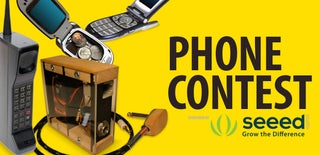Introduction: How to Make Mobile Controlled Car
Designed a Toy car that is controlled by a Mobile phone.
This Project implements the functionality of IVRS (Interactive Voice Response System) technology.
The car is controlled by a Mobile phone that makes a call to the phone attached to the Car. During the call, if any key is pressed, a DTMF (Dual Tone Multi Frequency) tone corresponding to the key is sent at the other end.
The received tone is processed by the Atmega16 microcontroller with the help of MT8870 DTMF decoder.
The decoder converts the tone into an equivalent binary code before sending it to the controller. The controller is pre-programmed to take a decision for any input and, outputs its decision to the motor driver that drives the car in various directions.
Using mobile phone to control the car helps overcoming the limitations of Range (a problem faced with RF systems).
Note: Interactive voice response (IVR) is a technology that allows a computer to interact with humans through the use of voice and DTMF tones input via keypad.
This project is an inspiration from the July 2008 issue of Electronics For You Magazine...!
Step 1: Components Needed
General Purpose PCB
7805 Voltage Regulator
ATmega16 Microcontroller
MT8870 DTMF Decoder
L293D Motor Driver
74LS04 NOT gate
1N4007 Rectifier diode
Resistors (¼-watt):
100-k.ohm --------------------------------------------------------x 2
330-k.ohm --------------------------------------------------------x 1
10-K.ohm ---------------------------------------------------------x 5
100-ohm ----------------------------------------------------------x 4
Capacitors:
0.1μF ceramic disk ---------------------------------------------x 2
22pF ceramic disk ----------------------------------------------x 4
10uf, 100uf Electrolytic Cap ---------------------------------x 2
Miscellaneous:
Old Earphones
Male and Female Header Pins
XTAL1 - 3.57MHz crystal
XTAL2 - 12MHz crystal
S1 - Push-to-on switch
6V, 50 RPM geared DC motor with mount ---------------x 2
Toy Car wheels -------------------------------------------------x 4
Battery - 6v, 4.5Ah
LED - 3mm (Any colour) --------------------------------------x 5
Old Plastic Pen or Straw
2" Nut and bolt --------------------------------------------------x 4
Step 2: Soldering Components
1. Start By soldering the ATmega16 Microcontroller and carefully place other components on the General Purpose PCB according to the schematics.
2. Solder them carefully according to the schematics.
Note:
In addition to the schematics, i designed 5v regulated power supply for the controller using 7805 voltage regulator IC. As long as Battery voltage is in range of microcontroller, there is no need for voltage control. In case of using batteries above 6v, use 7805 voltage regulator.
3. You will need to do track soldering in order to adjust the Circuit on a small PCB.
4. You can also make a PCB layout and develop a professional PCB.
Step 3: Preparing Phone Connection Cable
1. Cut an old Earphone at a distance of about 12" from the 3.5mm Audio connector.
2. Carefully Strip the insulated wire.
3. There will be two pairs of wires inside:
(i) Red - Gold
(ii) Blue - Gold
Note: These colour combinations vary with various Brands and Region.
4. Join the same coloured wires with each other or eliminate them (We don't require those). We only need two different coloured wires, one is Ring and other is Tip.
5. Remove the Red and Blue insulated coating from both the wires and solder them on a 2-Pin male Header.
6. You can also use Heat shrink tube to secure the connection of wires.
7. Check the connections using a multimeter and identify the Ring and Tip of the connector.
8. The two pin header will be connected on Circuit Board and 3.5 mm Audio pin on other side will be used to connect a Mobile Phone.
Step 4: Software for Atmega16
1. The software is written in C language.
2. I used AVR studio to write and compile the code. The code is very simple to understand and uses only basic functionality of the controller.
3. The Code text file and Hex are provided for reference.
4. Use any AVR burner to burn the provided Hex file into the controller.
Attachments
Step 5: Connect the Peripherals
- Drill holes for the Motor mounts on the edge of the circuit Board.
- Mount the two DC motors and the Wheels.
- On the front side, use any iron rode or a thin pencil as Axle to attach Wheels.
- Connect the mobile phone using the prepared earphone cable in step 4
- Set Mobile in Auto-answer mode while connected with earphone cable.
- Connect the battery, switch ON and verify the circuit. If everything went well, the front four LEDs should light up.
Step 6: Operating Car
1. Make a call from a Mobile phone to the phone connected to the Car.
2. As said earlier, this project uses the IVRS technology for controlling the car. A corresponding DTMF tone is sent for each key Press.
Press Key 2 - Move Forward
Press Key 8 - Move Backward
Press Key 5 - Stop
Press Key 4 - Turn Left
Press Key 6 - Turn Right
Note: Disconnect the call and remove the battery when not using the Toy car.
Step 7: Making Car Roof and Finalising the Design
We will now give our car an attractive look and design its roof, that will also act as platform for placing the Mobile Phone.
- Cut a PCB upto the required size of Roof.
- Drill Holes along the corners and corresponding holes on the circuit board.
- Cut an old pen or a straw in four equal pieces and using 2" nut - bolts attach the roof above the circuit board to give the car an attractive look.
Make this amazing gadget yourself and contact us or share your experiences on our facebook page, twitter and instagram. You can also SUBSCRIBE to our Youtube Channel GOODTECH - Creativity And Science, where i frequently post new and creative content.
I also made a wireless remote control powerful F1 racing car. Have a look at the instructable here or see the video below.
All The Best...Thanks for your Support...!!

Participated in the
Phone Contest

Participated in the
Soldering Challenge














